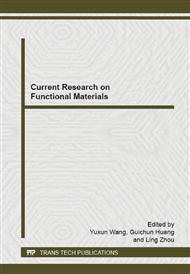p.240
p.245
p.252
p.257
p.263
p.268
p.276
p.283
p.290
Thermal Stabilities and the Thermal Degradation Kinetics Study of the Flame Retardant Epoxy Resins
Abstract:
Thermal stability and thermal degradation kinetics of epoxy resins with 2-(Diphenylphosphinyl)-1, 4-benzenediol were investegated by thermogravimetric analysis (TGA) at different heating rates of 5 K/min, 10 K/min, 20 K/min and 40 K/min. The thermal degradation kinetic mechanism and models of the modified epoxy resins were determined by Coast Redfern method.The results showed that epoxy resins modified with the flame retardant had more thermal stability than pure epoxy resin. The solid-state decomposition mechanism of epoxy resin and the modified epoxy resin corresponded to the controlled decelerating ځ˽̈́˰̵̳͂͆ͅ˼˰̴̱̾˰̸̵̈́˰̵̸̳̱̹̽̾̓̽˰̶̳̹̾̈́̿̾̓ͅ˰̶˸ځ˹˰̵̵͇͂˰̃˸́˽ځ˹2/3. The introduction of phosphorus-containing flame retardant reduced thermal degradation rate of epoxy resins in the primary stage, and promote the formation of carbon layer.
Info:
Periodical:
Pages:
263-267
Citation:
Online since:
October 2014
Authors:
Price:
Сopyright:
© 2014 Trans Tech Publications Ltd. All Rights Reserved
Share:
Citation:


